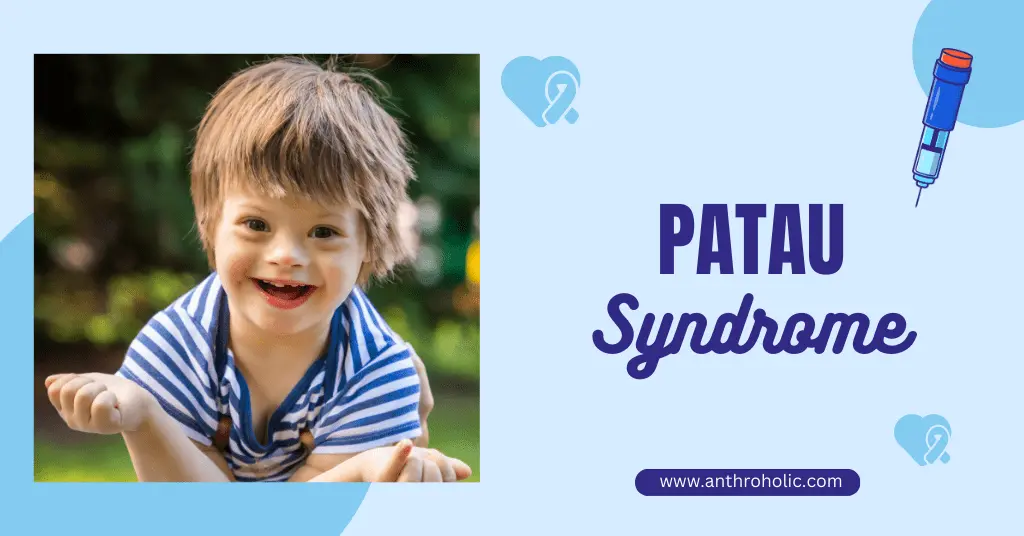AI Answer Evaluation Platform Live Now. Try Free Answer Evaluation Now
Patau Syndrome (Trisomy 13)
Patau syndrome, also known as Trisomy 13, is a severe genetic disorder that presents a variety of health challenges to those born with it. The condition is named after Dr. Klaus Patau, who, along with his colleagues, first described the disorder in 1960 (Patau et al., 1960). It is characterized by the presence of an extra 13th chromosome, which results in numerous physical and developmental abnormalities.

Etiology of Patau Syndrome
Genetic Causes
Patau syndrome occurs due to a genetic anomaly during cell division, resulting in the presence of a full or partial extra copy of chromosome 13. It is predominantly caused by three distinct genetic events:
- Full Trisomy 13: This is the most common cause, accounting for approximately 80% of cases. In this instance, an extra copy of chromosome 13 appears in every cell in the body.
- Trisomy 13 Mosaicism: Accounting for around 5% of cases, trisomy 13 mosaicism occurs when the extra chromosome 13 only appears in some cells, not all.
- Partial Trisomy 13: This rare type occurs when a portion of chromosome 13 becomes attached (translocated) to another chromosome during cell division, resulting in extra genetic material from chromosome 13.
Symptoms and Complications
The signs and symptoms associated with Patau syndrome vary considerably among individuals, but some are more prevalent than others. Major symptoms include:
- Physical Abnormalities: These typically include cleft lip or palate, small or abnormally shaped eyes (microphthalmia), extra fingers or toes (polydactyly), and decreased muscle tone (hypotonia).
- Neurological Issues: Severe intellectual disability is a common feature. Seizures, abnormal brain structures, and hearing loss also often occur.
- Cardiovascular Problems: Over 80% of individuals with Patau syndrome are born with congenital heart defects, the most common being atrial or ventricular septal defects.
- Respiratory Complications: Breathing problems are common, often due to issues like apnea or lung malformations.
- Gastrointestinal Issues: These may include abdominal organ malformations, such as omphalocele or hernias.
Diagnosis of Patau Syndrome
Diagnosing Patau syndrome can be done prenatally or after birth, employing various testing methods.
- Prenatal Diagnosis: This involves tests like amniocentesis, chorionic villus sampling (CVS), and non-invasive prenatal testing (NIPT).
- Postnatal Diagnosis: Postnatal diagnosis can be confirmed through a physical examination, noting the presence of common physical signs, followed by genetic testing.
Table 1: Comparison of Prenatal Diagnostic Methods
| Diagnostic Method | When it’s done | Procedure | Risk |
|---|---|---|---|
| Amniocentesis | Usually between 15 and 20 weeks of pregnancy | A needle is used to withdraw a small amount of amniotic fluid for testing | Miscarriage risk (about 0.1% – 0.3%) |
| Chorionic Villus Sampling (CVS) | Between 10 and 12 weeks of pregnancy | A small sample of cells is taken from the placenta for testing | Miscarriage risk (about 0.5% – 1%) |
| Non-Invasive Prenatal Testing (NIPT) | After 9 weeks of pregnancy | Blood is drawn from the mother to analyze cell-free fetal DNA | No known physical risk to mother or baby |
Treatment and Management
Patau syndrome has no cure; instead, treatment revolves around managing the symptoms and improving the quality of life for the individual. Interventions can be broad and often involve a multidisciplinary team of healthcare professionals.
- Medical Management: This can include surgeries for heart defects, respiratory support for breathing difficulties, and medications to manage seizures.
- Therapies: Physical, occupational, and speech therapy can assist with developmental issues.
Life Expectancy and Prognosis
The prognosis for individuals with Patau syndrome is generally poor due to the severity of the associated health issues. Many fetuses with the condition do not survive to birth, and those who are born live often only survive for a few days or weeks. However, a small percentage of individuals with milder forms of the condition, such as trisomy 13 mosaicism, can live into adolescence and beyond.
Conclusion
Understanding Patau syndrome involves grappling with complex genetic principles and confronting a challenging prognosis. This genetic disorder, while relatively rare, has profound implications for those affected and their families. By broadening our knowledge and understanding, we can better support these individuals and their families, contribute to ongoing research, and hopefully pave the way toward improved treatment options in the future.
References
Patau, K., Smith, D. W., Therman, E., Inhorn, S. L., & Wagner, H. P. (1960). Multiple congenital anomaly caused by an extra autosome. The Lancet, 275(7128), 790-793. https://doi.org/10.1016/S0140-6736(60)90676-0



